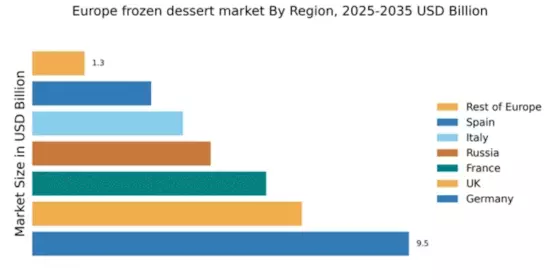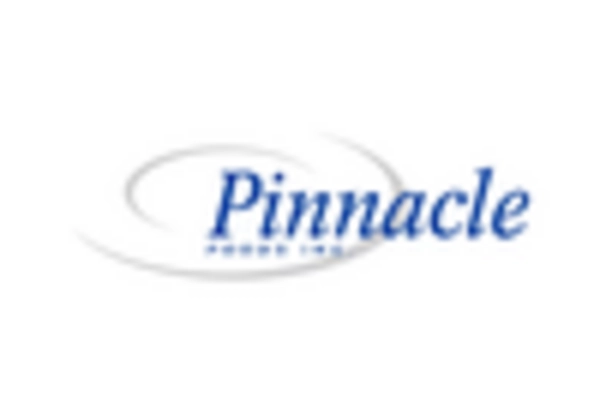Innovative Flavor Profiles
The frozen dessert market is witnessing a surge in demand for unique and innovative flavor profiles. Consumers are increasingly adventurous in their culinary choices, seeking out exotic and unconventional flavors that provide a novel experience. This trend is supported by market data, which shows that sales of non-traditional flavors, such as matcha, lavender, and salted caramel, have increased by approximately 20% in the last year. Manufacturers are responding to this demand by experimenting with new ingredients and flavor combinations, thereby expanding their product offerings. This focus on innovation not only attracts consumers but also enhances brand differentiation in a competitive market. As the appetite for unique flavors continues to grow, it is likely that the frozen dessert market will see further diversification in its product range.
Seasonal and Festive Offerings
Seasonality plays a crucial role in shaping consumer behavior within the frozen dessert market. During festive periods, there is a notable increase in demand for seasonal flavors and themed products. Market data suggests that sales of frozen desserts during the holiday season can increase by as much as 30%, driven by consumer desire for indulgent treats that align with celebratory occasions. Manufacturers are responding to this trend by launching limited-edition flavors and festive packaging that resonate with consumers' seasonal preferences. This strategy not only boosts sales during peak periods but also enhances brand visibility and engagement. As the trend for seasonal offerings continues, it is likely that the frozen dessert market will see an ongoing emphasis on creativity and innovation in product development.
Convenience and On-the-Go Options
The fast-paced lifestyle of modern consumers is driving the demand for convenience in the frozen dessert market. As individuals seek quick and easy dessert options, single-serve packaging and ready-to-eat products are becoming increasingly popular. Recent market analysis indicates that single-serve frozen desserts have experienced a growth rate of approximately 25% over the past year, reflecting the changing preferences of busy consumers. Brands are capitalizing on this trend by offering portable and easy-to-consume options that cater to on-the-go lifestyles. This shift towards convenience is likely to continue influencing product development and marketing strategies within the frozen dessert market, as manufacturers strive to meet the needs of time-strapped consumers.
Health-Conscious Consumer Behavior
The increasing awareness of health and wellness among consumers appears to be a driving force in the frozen dessert market. As individuals become more health-conscious, they tend to seek out products that align with their dietary preferences, such as low-calorie, low-sugar, and organic options. This shift is reflected in market data, indicating that the demand for healthier frozen desserts has surged, with a notable increase of approximately 15% in sales of low-calorie options over the past year. Consequently, manufacturers are adapting their product lines to cater to this trend, introducing innovative flavors and formulations that appeal to health-oriented consumers. This evolution in consumer preferences is likely to continue shaping the frozen dessert market, as brands strive to balance indulgence with health benefits.
Sustainability and Eco-Friendly Practices
Sustainability has emerged as a pivotal driver in the frozen dessert market, as consumers increasingly prioritize environmentally friendly products. The demand for sustainable packaging and ethically sourced ingredients is on the rise, with a significant portion of consumers willing to pay a premium for products that align with their values. Recent surveys indicate that approximately 60% of European consumers consider sustainability when making purchasing decisions. This trend has prompted manufacturers to adopt eco-friendly practices, such as using biodegradable packaging and sourcing ingredients from sustainable farms. As a result, brands that emphasize their commitment to sustainability are likely to gain a competitive edge in the frozen dessert market, appealing to a growing segment of environmentally conscious consumers.


















Leave a Comment